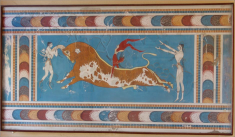Conveners
Workshop on QCD
- Owe Philipsen (Goethe University Frankfurt)
Workshop on QCD
- Lorenz von Smekal (Justus-Liebig University Giessen)
Workshop on QCD
- Christian Fischer (JLU Gießen)
Workshop on QCD
- Jeff Greensite (San Francisco State University)
We present new results for fluctuations of the baryon number for QCD with
Nf=2+1 quark flavours at non-zero temperature and chemical potential [1].
These are extracted from a framework based on a combination of lattice QCD
and Dyson-Schwinger equations. In previous works ([2], see [3] for a review)
we found a critical end point in the region ($T^c,\mu_B^c$)=(120,500) MeV.
We discuss...
Low-energy QCD at finite temperatures and baryochemical densities predicts a phase transition from a chiral symmetry broken hadronic phase to a chirally restored quark-gluon plasma phase. In this talk the two and three quark flavor chiral phase structure with and without an axial U(1)-symmetry breaking is the major focus. The current status of low-energy QCD effective models is briefly...
Fluctuations of conserved charges such as baryon number, electric charge and strangeness [1,2] may provide a test for completeness of states in lattice QCD for three light flavors [3-7]. We elaborate on the idea that the corresponding susceptibilities can be saturated with excited baryonic states with an underlying quark-diquark structure with a linearly confining interaction. Using...
We point out a distinction, in gauge theories with matter in the fundamental representation, between color confinement and a stronger version of confinement, which we call “separation of charge” confinement. The latter is a generalization of the Wilson area-law criterion to gauge+matter theories . In gauge-Higgs theories, we show that the transition (which is not necessarily a thermodynamic...
The branching of center vortices in SU(3) Yang-Mills theory in maximal center gauge is analyzed. When properly normalized, one can define a branching probability that turns out to be independent of the lattice spacing (in the limited scaling window studied here). The branching probability shows a rapid change at the deconfinement phase transition which is much more pronounced in space slices...
We discuss dense cool QCD where a region with spatially inhomogeneous condensates may emerge. In that case, QCD phase diagram may exhibit a Lifshitz regime, which can appear either instead of, or in addition to Critical End Point. We study the Lifshitz regime using a combination of large-N expansion and numerical lattice simulations.
In this talk recent progress on the phase structure of QCD and transport processes with the functional renormalisation group are reviewed. I present an update of the phase boundary that is in agreement with recnet lattice results. At larger density we also find indictations for an inhomgeneous phase as well as a critical end point.
The method is also used for the computation of transport...
During the last years it has become possible to address the cold and dense regime of QCD directly for
sufficiently heavy quarks, where combined strong coupling and hopping expansions are convergent and a
3d effective theory can be derived, which allows to control the sign problem either in simulations or by fully
analytic calculations. In this
contribution we review the effective theory...
The Functional Renormalization Group (FRG) can be used to calculate spectral functions from analytically continued FRG flow equations for two-point correlation functions. Here we report on the current status of applying this aFRG framework to the calculation of vector and axial-vector meson spectral functions in effective hadronic theories at finite temperature and density. Their medium...
Some years ago, relying on standard functional manipulations, a new property of QCD fermionic Green’s functions has been put forth and called effective locality. This feature of QCD is non-perturbative, as resulting from a full integration of the gluons degrees of freedom. At least at quenching and a mild eikonal approximation, the relation of effective locality to dynamical chiral symmetry...
Local formulations of quantum field theory imply that gauge theory propagators can potentially contain generalised infrared poles. In this talk I will outline the theoretical significance of these components, and report on recent lattice fit results for the gluon propagator.
We present a relativistic constituent-quark model extended to describe all known baryons on a uniform basis. The corresponding Poincaré-invariant mass operator relies on a linear confinement and a hyperfine interaction derived from Goldstone-boson exchange. The relativistic three-quark system is solved along modified Faddeev equations adapted to treat long-range interactions. While the...
From a UV-complete top-down holographic dual of large-N thermal QCD at finite gauge coupling, we discuss a variety of topics like obtaining a lattice-compatible T_c, conformal anomaly, lattice/PDG-compatible glueball/meson spectroscopy and glueball-to-meson decays, speed of sound, (lattice-compatible) shear viscosity(eta)-to-entropy density ratio's variation with temperature, bulk...
We study various topological objects corresponding to baryons in holographic QCD [1,2,3]. The holographic QCD is constructed with D4 and D8-branes in the superstring theory, and is equivalent to 1+3 dimensional QCD in an infrared region. We investigate instantons and monopoles topologically appearing in holographic QCD in two-flavor case.
[1] T. Sakai and S. Sugimoto, Prog. Theor. Phys. 113...
The production of prompt isolated photons, W-bosons and Z-bosons in proton-proton collisions provides a stringent test of perturbative QCD and yields important information about the parton distribution functions (PDFs) for quarks within the proton. In this talk, we present precision measurements of these final states across four different proton-proton centre-of-mass energies using data...
